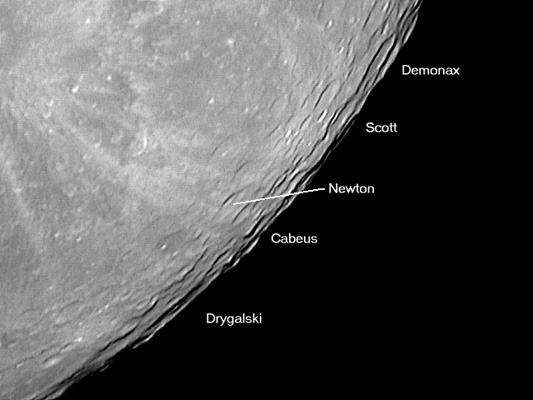Difference between revisions of "January 5, 2004"
(Created page with "__NOTOC__ =South Polar Wilderness= ---- ===COMMENTS?=== Click on this icon image:PostIcon.jpg at the upper right to post a comment.") |
|||
| (12 intermediate revisions by the same user not shown) | |||
| Line 1: | Line 1: | ||
__NOTOC__ | __NOTOC__ | ||
=South Polar Wilderness= | =South Polar Wilderness= | ||
| − | + | <!-- Start of content --> | |
| − | + | <table width="85%" border="0" align="center" cellpadding="4" cellspacing="2"> | |
| − | + | <tr> | |
| − | ---- | + | </tr> |
| − | === | + | </table> |
| − | + | <table width="640" border="0" align="center" cellpadding="6" cellspacing="2"> | |
| + | <tr> | ||
| + | <td> | ||
| + | <div align="center"> | ||
| + | [[File:LPOD-2004-01-05.jpeg|LPOD-2004-01-05.jpeg]] | ||
| + | <br> | ||
| + | <span class="main_sm"><b>Image Credit:</b> | ||
| + | [mailto:briansj.jeffrey@ntlworld.com Brian Jeffrey] | ||
| + | </span> | ||
| + | </div> | ||
| + | </td> | ||
| + | </tr> | ||
| + | </table> | ||
| + | <table class="story" border="0" bgcolor="#FFFFFF" width="90%" cellpadding="10" align="center"> | ||
| + | <tr> | ||
| + | <td valign="top"> | ||
| + | <p class="story" align="center"> | ||
| + | <b>South Polar Wilderness</b></p> | ||
| + | <p class="story">Most observers point their telescopes at the mare regions of the Moon - and part of the reason is that it is far easier | ||
| + | to find things there! The further you get from the maria, the more the Moon appears as a wilderness of crater piled upon | ||
| + | crater. One of the most difficult regions to find your way around is near the lunar south pole. Brian Jeffrey explored | ||
| + | this area at full Moon on Feb 16, 2003 when the terminator slid around from the west, passed the pole, and moved to the | ||
| + | east. His technical details suggest that the south pole may be less confusing than modern imaging techniques!</p> | ||
| + | <p><b>Technical Details:</b><br> | ||
| + | <i>"I used my 102mm f/5 chinese refractor with x2 barlow, IRB filter, Mogg adapter and Toucam Pro webcam. Avi's were captured | ||
| + | in K3CCDTools, processed in Registax and finished in PSPro5. For this image, 135 frames were captured at 5 frames/sec, | ||
| + | shutter 1/250sec, gamma 5%, brightness 60%, satn. 0 (greyscale), gain 10%. K3CCDTools pixel meter Registered 200/0. | ||
| + | 20 best frames were stacked, wavelet processed and the resulting bmp was converted to a reasonable-sized jpg."</i> - Brian Jeffrey</p> | ||
| + | <p><b>Related Links:</b> | ||
| + | <br> | ||
| + | [http://antwrp.gsfc.nasa.gov/apod/ap951128.html South Pole]<br> | ||
| + | [http://www.novaspace.com/ORIG/Davis/Moon.html South Pole in Art]<br> | ||
| + | [http://www.pk3.org/Astro/ K3CCDTools]<br> | ||
| + | [http://aberrator.astronomy.net/registax/ Registax]<br> | ||
| + | [http://webcaddy.com.au/astro/adapter.htm Moog Webcam Adapter]</p> | ||
| + | <p><b>Yesterday's LPOD:</b> [[January 4, 2004|Rising Moon]] </p> | ||
| + | <p><b>Tomorrow's LPOD:</b> [[January 6, 2004|Gores of the Moon]] </p> | ||
| + | <!-- bottom --> | ||
| + | </td> | ||
| + | </tr> | ||
| + | </table> | ||
| + | <hr> | ||
| + | <p align="center" class="main_titles"><b>Author & Editor:</b><br> | ||
| + | [mailto:tychocrater@yahoo.com Charles A. Wood]</p> | ||
| + | <!-- Cleanup of credits --> | ||
| + | <!-- Cleanup of credits --> | ||
| + | <!-- Cleanup of credits --> | ||
| + | <!-- Cleanup of credits --> | ||
| + | <!-- Cleanup of credits --> | ||
| + | <!-- Cleanup of credits --> | ||
| + | <!-- Cleanup of credits --> | ||
| + | <p> </p> | ||
| + | <!-- End of content --> | ||
| + | {{wiki/ArticleFooter}} | ||
Latest revision as of 11:12, 6 June 2015
South Polar Wilderness
|
|
|
South Polar Wilderness Most observers point their telescopes at the mare regions of the Moon - and part of the reason is that it is far easier to find things there! The further you get from the maria, the more the Moon appears as a wilderness of crater piled upon crater. One of the most difficult regions to find your way around is near the lunar south pole. Brian Jeffrey explored this area at full Moon on Feb 16, 2003 when the terminator slid around from the west, passed the pole, and moved to the east. His technical details suggest that the south pole may be less confusing than modern imaging techniques! Technical Details: Related Links:
Yesterday's LPOD: Rising Moon Tomorrow's LPOD: Gores of the Moon |
Author & Editor:
Charles A. Wood
COMMENTS?
Register, Log in, and join in the comments.




